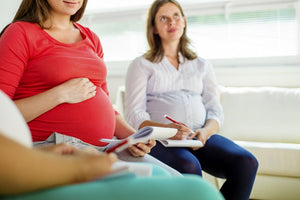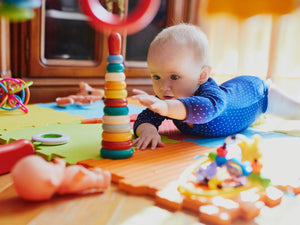In my last article I talked about Intrahepatic Cholestasis of Pregnancy (ICP) and made a brief reference to having had an extended breech presentation. So as a follow on, here is that story!
My first child was an extended breech birth but went undiagnosed till week 38. I was having itching due to my Intrahepatic Cholestasis of Pregnancy (ICP), which was also undiagnosed at that stage too. My blood pressure had gone up and I was very stressed.
My obstetrician thought that I should be induced and so he did a pelvic examination and to his horror he could not feel a head, he felt a butt! The baby’s head was at the top but as I had always felt kicking at the top nobody even thought that she might be lying in an awkward position.
He scheduled me for a caesarean section that night, I was 31, had high blood pressure and he did not think I could deliver the baby naturally without putting her at considerable risk.
I had wanted a general anaesthetic as the thought of an epidural scared me so much, but yet again my body let me down! Because my sister had trouble waking from a general anaesthetic (when she had her wisdom teeth removed) they thought I might have Scoline Apnoea and so blood tests were done, which later proved positive, so I had to have an epidural.
It wasn’t nearly as bad as I had thought it would be and in the end I was glad I’d had the epidural, as I could be involved in the birth and see her the minute she was born.
For weeks after her birth she would lie in her cot with her feet by her head, it was her foetal position after all! We called her our little frog! She had “clicky” hips (sometimes a sign of hip dysplasia) at her postnatal check, due to her intrauterine position, but an ultrasound at 6 weeks was normal and thankfully she didn’t have dysplastic hips.
What is a Breech Position?
During most of pregnancy, there is enough room in the uterus for the baby (foetus) to change position. By 36 weeks of pregnancy, most babies turn into a head-down position. This is the normal and safest foetal position for birth.
But in about 4 out of 100 births, the baby doesn't naturally turn head-down. Instead, the baby is in a breech position. There are three main breech positions:
Complete breech
The buttocks are down near the birth canal. The knees are bent, and the feet are near the buttocks.
Frank/Extended breech
The buttocks are in place to come out first during delivery. The legs are straight up in front of the body, with the feet near the head. This is the most common type of breech position.
Incomplete/Footling breech
One leg or both legs are stretched out below the buttocks. The leg or legs are in place to come out first during delivery.
What causes baby to assume a breech position?
Most of the time, there is no clear reason why the baby did not turn head-down. In some cases, breech position may be linked to early labour, multiples, problems with the uterus, or problems with the baby.
What are the signs that baby is in a breech position?
You probably won't be able to feel whether your baby is breech. But if you are 36 or more weeks pregnant and think you feel the baby’s head pressing high up in your belly or you feel kicking in your lower belly, see your doctor for an exam.
How is a breech position diagnosed?
During a routine exam late in your pregnancy, your doctor will feel your upper and lower belly and may do a foetal ultrasound to find out if your baby is breech. Your doctor may also learn that your baby is breech when he or she checks your cervix.
How is breech position treated?
Sometimes a doctor can turn a baby from a breech position to a head-down position by using a procedure called an external cephalic version. (If you are using a midwife and your baby is in breech position, your midwife will refer you to a doctor for this procedure.) If the baby can be turned head-down before labour starts, you may be able to have a vaginal birth.
You also can ask your doctor if you can try certain positions at home that may help turn your baby. This is called postural management. There is no research to prove that this works, but it’s not harmful. It may work for you.
It’s normal to feel disappointed and worried about a breech pregnancy, especially if the doctor has tried to turn the baby without success. But most breech babies are healthy and don't have problems after birth.
Having a breech presentation is more likely to result in a caesarean section, but at the end of the day making sure your child is born healthy and with the least amount of risk is the most important factor.
I have now had four caesareans and four healthy babies and that is what truly matters at the end of the day.
Source: Breech Position and Breech Birth - Topic Overview. (2011, July 25).
About the Author:
Written for Nourish Baby by Corinne. Corinne, together with her partner Mary McClure are Precious Kids Great Parents - two mums with over 59 years combined child rearing experience. Between them they have 9 kids, 3 grand children, have had 4 caesareans, 1 miscarriage, 4 natural no drug births and a foster child! They also have over 60 years of work experience in the fields of medicine, education and counselling.
Our Products
-

01. Guide to a Healthy Pregnancy
$55 -

02. Positive Birthing Course
$55 -

03. Infant Feeding Guide
$55 -

04. Baby Sleep Guide - First 12 Months
$55 -

05. Toddler Parenting Course 1 - 3 Years
$55
-
 When to Start Antenatal Classes?
When to Start Antenatal Classes?
Becoming a parent is an incredible milestone, but it comes with a host of changes that can be daunting, especially for first time parents. Antenatal classes are all about offering expectant parents the education they need to make informed decisions, look after their bodies and care for their newborn babies. While you probably already have a long list of things you need to accomplish during your pregnancy, it’s a good idea to make time to attend antenatal classes.
-
 Development Milestones 4-8 Months
Development Milestones 4-8 Months
As they reach the middle of their first year, you'll start to see bigger leaps in their growth and ability!
In this article, we’re going to discuss your baby’s developmental milestones between 4-8 months, and what you can expect along the way.





 When to Start Antenatal Classes?
When to Start Antenatal Classes?
 Development Milestones 4-8 Months
Development Milestones 4-8 Months








